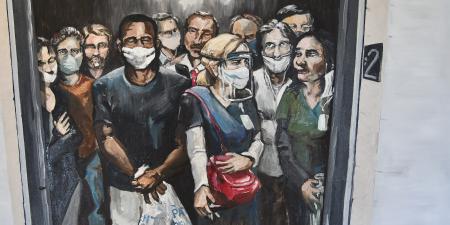Abstract
Compassion has long been a bulwark of mental health law. Civil commitment, guardianship, mandated clinical intervention, diversion courts, involuntary medication, insanity defenses, and aid-in-sentencing evaluations are all elements of compassionate mental health practice. Parens patriae (the state as parent) and the least restrictive alternative are the specific concepts supporting therapeutic intention and purpose and are particularly relevant in cases in which force may be needed in the course of a patient’s care. This article considers how using law compassionately can be evident even in forced clinical interventions.
Therapeutic Jurisprudence
There has always been compassion in mental health law, especially when leverage is needed to protect patients from dangerous behavior or decisions. Civil commitment, for example, implies care in placing persons diagnosed with mental illness in hospitals, especially when they would otherwise refuse and be a risk to themselves or others. Civil commitment is an opportunity for people to address symptoms of mental illness in a more therapeutic environment than jail or prison. In placing people with mental illness in environments more likely to promote recovery, civil commitment can be seen as a compassionate exercise. Guardianship, too, assigns a trusted advisor or family member to assist in decision making for patients who are incompetent. These approaches are based in therapeutic jurisprudence, which utilizes legal proceedings for therapeutic ends.1 Fundamentally, the principle explores the therapeutic implications of the legal process.
Compassionate Thinking in Law and Medicine
At the 2019 annual meeting of the American Academy of Psychiatry and the Law, forensic psychiatrists who had contributed significantly to the evolution of compassionate thinking in law and medicine presented their work at a workshop.2 In seminal writings for the profession decades earlier, discussant Ezra Griffith of Yale University had advocated for a cultural formulation of assessments conducted for the courts that accounted for the experience of people of color.3 His clarion call has become prescient in light of deaths in custody like those of George Floyd, raising questions about the true protections of constitutional rights.4 For a large swath of the profession, Griffith can be said to have triggered a reexamination of compassion when physicians conduct civil and criminal work.
Joined over the years by some of his colleagues on the panel that day, Griffith explored narrative ethics, especially storytelling as a way to evaluate the experiences and behaviors of those caught in an unsympathetic judicial system. Narrative ethics was a pioneering attempt across disciplines to bring to bear humanistic values in fields such as medicine,5 as well as in philosophy, history, economics, and law. With the realities of uneven treatment of disadvantaged persons clear to both the clinical and the forensic professions, professional legal ethics had to speak directly to the structural injustices that resulted in the greater arrest, arraignment, prosecution, and punishment of persons of color. Indeed, the social determinants of health and health disparities themselves were already recognized.6
Panelist Michael Norko argued that compassion had to find its way into forensic and legal practice if the human experience was to count for anything in psychological evaluations for the courts.7 Norko holds that compassion gives professionals an “approach to justice that allows us to attend to and engage the humanity of all the subjects of our evaluations.”7 Through compassion, professionals are able to recognize and respect humanity in all persons with whom they engage, no matter their background. This compassion is essential because, without it, police and judges, just like forensic experts, simply perpetuate existing inequities.
Supported by writings of the American Medical Association (AMA) on vulnerable people and values,8 2 other panelists, the second author (P.J.C.) and Richard Martinez, built on the AMA’s view of professionalism as something structurally stabilizing and morally protective. An antiseptic or technical exercise of law was not enough to ensure justice for participants in legal processes. Justice had to be informed by a person’s specific circumstances and the social determinants of their court involvement. Otherwise, courts, community, and participants were deprived of nuance and context. Procedures alone removed the humanity and social meaning from the legal interaction—an interaction that required empathy and compassion to capture history and social context.9
Compassion and Dignity
The compassion Norko finds at the heart of ethical forensic practice may be linked to a fundamental precept in modern philosophy: dignity. Dignity of the person is specifically identified by Alec Buchanan as the aspect of personhood most deserving of unconditional respect.10 American jurisprudence, for example, provides certain fundamental protections to those in its control: access to an attorney, the presumption of innocence, a jury of one’s peers. Echoing the writing of philosophers from Thomas Aquinas to Immanuel Kant, Buchanan is among those who recognize an inherent worth to human existence. Whether endowed by the Creator or by humanity itself, dignity exists by virtue of one’s capacity to be moral, to make decisions, and even to aspire to an ideal.10 Dignity thus goes beyond the law’s inherent respect for one’s autonomy or self-rule.
Dignity thus goes beyond the law’s inherent respect for one’s autonomy or self-rule.
Modern conceptions of dignity demonstrate its close connection to compassion. With its etymological roots in the Greco-Roman dignitas, dignity has been loosely translated as the state or quality of earning respect, honor, or self-esteem.11 Social rank played a large role in its classical meaning, while Griffith describes it as more akin to “wisdom, rank, and position,” as well as “essential and inviolable humanity.”2 Utilizing this more modern working definition, compassion for people caught in the legal system may be seen in many of society’s efforts to find dignity among those accused of transgressions against it.
Parens Patriae and Least Restrictive Alternatives
The ethos of compassion in involuntary treatment is traditionally justified by the doctrine of parens patriae, the state as parent. Although the state is not always the disciplinarian, it is the resolver of disputes, the de-escalator, the keeper of the peace. The doctrine is often applied in cases of juveniles or adults with disabilities that affect their executive functioning.12 Within parens patriae, the least restrictive alternative limits the law’s parental controls. Landmark legal cases13,14 ensure involuntary patients the maximum level of freedom while their illness continues to be treated safely.
Involuntary treatment as an extension of parens patriae. Applying legal oversight and the least restrictive alternative to involuntary treatment can help allay some of the fears that patients experience in receiving such care. An argument for treating patients without the capacity to make their own decisions is that it respects patients’ humanity. In this view, withholding treatment from persons without decision-making capacity is neither compassionate nor right. After all, patients with untreated mental illness receiving competency restoration services are often suffering both from the inability to understand their situation and from the symptoms of their illness.15
Outpatient commitment as an expression of the least restrictive alternative. Legal oversight of inpatient commitment and the least restrictive alternative ensure that the law is appropriately limited to specific populations with specific problems that can be managed in a clinical setting. The legal rules place the burden of arranging alternatives on the state so that individuals have access to the complete set of options that support individual liberty. Outpatient commitment—in which courts order outpatient treatment under threat of rehospitalization or rehearing—is a specific version of the least restrictive alternative.16 Yet even this less restrictive alternative has been criticized for its broader application to people of color.17
Treating Defendants
Aid-in-sentencing. Aid-in-sentencing evaluations allow the law to appeal to values of care for defendants undergoing sentencing. Exploring defendants’ life circumstances and clinical history helps courts assess the harm a correctional setting can do and is a significant intervention for vulnerable persons diagnosed with mental illness. Psychiatrists can offer a variety of recommendations to place or treat defendants experiencing mental illness. These lesser-known evaluations join insanity defenses as an example of attempts to treat defendants with the compassion due their condition—a condition that may not allow them to shoulder responsibility for their actions.
Diversion. Diversion encompasses several compassionate substitutes for the traditional court model. Drug courts, mental health courts, and Veterans’ courts are compassionate means of mitigating potentially harmful effects of the judicial system on persons with treatable conditions. Drug courts, for example, use the leverage of pending charges to compel treatment, offering the opportunity for recovery rather than punishment. Graduation ceremonies from drug courts are often moving affairs, attended by family members, court officers, and recovery professionals.
Conclusion
The cultural formulation of forensic ethics, narrative ethics, the doctrine of therapeutic jurisprudence, professionalism, clinical consultation to the courts, and diversion efforts tie compassion tightly to the law through the fundamental dignity of persons. Compassion is consequently an influential component of a judicial system that strives to do more than provide mere procedures that distinguish guilty from not guilty, competent from incompetent, dangerous from harmless. There is an entire framework for using clinical interventions to restore competence, treat underlying mental illness, and return justice-involved persons to their communities. At a time when compassion can be difficult to find in law and its enforcement, these mechanisms can remind us of humanistic influences on society’s behavior.
References
- Wexler DB, Winick BJ. Therapeutic jurisprudence and criminal justice mental health issues. Ment Phys Disabil Law Rep. 1992;16(2):225-231.
- Griffith EEH. Empathy, compassion, and dignity in forensic psychiatry. Psychiatr News. 2020;55(3):12-13.
- Griffith EE. Ethics in forensic psychiatry: a cultural response to Stone and Applebaum. J Am Acad Psychiatry Law. 1998;26(2):171-184.
-
Tyler R, Luban SA. Police use of force, training, and a way forward after the death of George Floyd. SLS Legal Aggregate blog. June 4, 2020. Accessed September 21, 2020. https://law.stanford.edu/2020/06/04/police-use-of-force-training-and-a-way-forward-after-the-death-of-george-floyd
- Lagay FL. The ethical force of stories: narrative ethics and beyond. Virtual Mentor. 2014;16(8):622-625.
- Graham H. Social determinants and their unequal distribution: clarifying policy understandings. Milbank Q. 2004;82(1):101-124.
- Norko MA. Commentary: compassion at the core of forensic ethics. J Am Acad Psychiatry Law. 2005;33(3):386-389.
- Wynia MK, Latham SR, Kao AC, Berg JW, Emanuel LL. Medical professionalism in society. N Engl J Med. 1999;341(21):1612-1616.
-
Candilis PJ, Weinstock R, Martinez R. Forensic Ethics and the Expert Witness. Springer Science Business Media; 2007.
-
Buchanan A. Respect for dignity and forensic psychiatry. Int J Law Psychiatry. 2015;41:12-17.
-
Rosen M. Dignity: Its History and Meaning. Harvard University Press; 2012.
-
Legal Dictionary. September 20, 2015. Accessed July 15, 2020. https://Legaldictionary.net/parens-patriae
-
Lake v Cameron, 267 F Supp 155 (DC Cir 1967).
-
Rouse v Cameron, 387 F2d 241 (DC Cir 1967).
- Johnson NR, Candilis PJ. Outpatient competence restoration: a model and outcomes. World J Psychiatry. 2015;5(2):228-233.
-
Involuntary outpatient commitment. Harvard Mental Health Letter. August 2008. Accessed July 15, 2020. https://www.health.harvard.edu/newsletter_article/Involuntary_outpatient_commitment
-
Swanson J, Swartz M, Van Dorn RA, et al. Racial disparities in involuntary outpatient commitment: are they real? Health Aff (Millwood). 2009;28(3):816-826.



